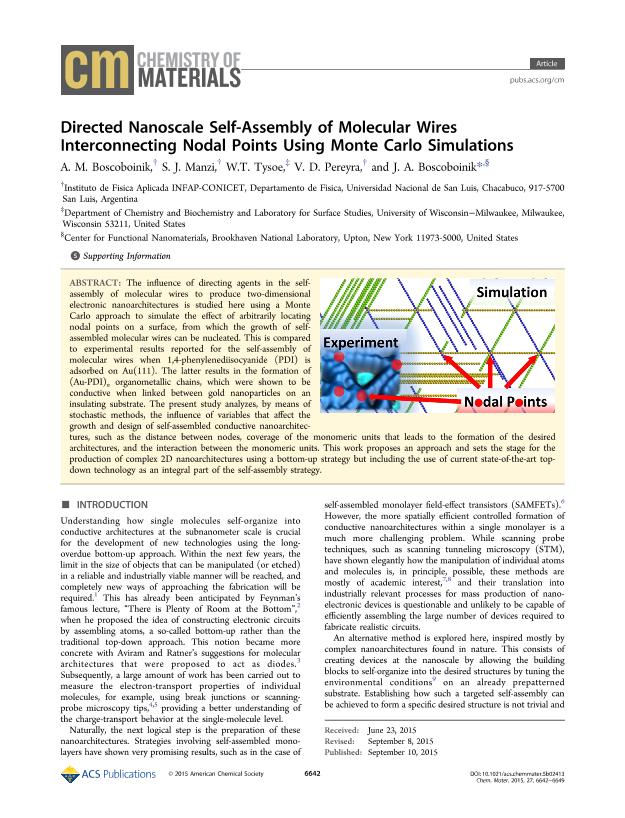Mostrar el registro sencillo del ítem
dc.contributor.author
Boscoboinik, Alejandro Miguel

dc.contributor.author
Manzi, Sergio Javier

dc.contributor.author
Tysoe, W. T.
dc.contributor.author
Pereyra, Victor Daniel

dc.contributor.author
Boscoboinik, Alejandro Miguel

dc.date.available
2018-09-21T15:57:52Z
dc.date.issued
2015-09
dc.identifier.citation
Boscoboinik, Alejandro Miguel; Manzi, Sergio Javier; Tysoe, W. T.; Pereyra, Victor Daniel; Boscoboinik, Alejandro Miguel; Directed Nanoscale Self-Assembly of Molecular Wires Interconnecting Nodal Points Using Monte Carlo Simulations; American Chemical Society; Chemistry Of Materials; 27; 19; 9-2015; 6642-6649
dc.identifier.issn
0897-4756
dc.identifier.uri
http://hdl.handle.net/11336/60570
dc.description.abstract
The influence of directing agents in the self-assembly of molecular wires to produce two-dimensional electronic nanoarchitectures is studied here using a Monte Carlo approach to simulate the effect of arbitrarily locating nodal points on a surface, from which the growth of self-assembled molecular wires can be nucleated. This is compared to experimental results reported for the self-assembly of molecular wires when 1,4-phenylenediisocyanide (PDI) is adsorbed on Au(111). The latter results in the formation of (Au-PDI)n organometallic chains, which were shown to be conductive when linked between gold nanoparticles on an insulating substrate. The present study analyzes, by means of stochastic methods, the influence of variables that affect the growth and design of self-assembled conductive nanoarchitectures, such as the distance between nodes, coverage of the monomeric units that leads to the formation of the desired architectures, and the interaction between the monomeric units. This work proposes an approach and sets the stage for the production of complex 2D nanoarchitectures using a bottom-up strategy but including the use of current state-of-the-art top-down technology as an integral part of the self-assembly strategy.
dc.format
application/pdf
dc.language.iso
eng
dc.publisher
American Chemical Society

dc.rights
info:eu-repo/semantics/openAccess
dc.rights.uri
https://creativecommons.org/licenses/by-nc-sa/2.5/ar/
dc.subject
Nanoarchitectures
dc.subject
Molecular Wires
dc.subject
Self-Assembly
dc.subject
Monte Carlo Simulation
dc.subject.classification
Otras Ciencias Químicas

dc.subject.classification
Ciencias Químicas

dc.subject.classification
CIENCIAS NATURALES Y EXACTAS

dc.title
Directed Nanoscale Self-Assembly of Molecular Wires Interconnecting Nodal Points Using Monte Carlo Simulations
dc.type
info:eu-repo/semantics/article
dc.type
info:ar-repo/semantics/artículo
dc.type
info:eu-repo/semantics/publishedVersion
dc.date.updated
2018-09-20T13:13:20Z
dc.journal.volume
27
dc.journal.number
19
dc.journal.pagination
6642-6649
dc.journal.pais
Estados Unidos

dc.journal.ciudad
Washington
dc.description.fil
Fil: Boscoboinik, Alejandro Miguel. Consejo Nacional de Investigaciones Científicas y Técnicas. Centro Científico Tecnológico Conicet - San Luis. Instituto de Física Aplicada ; Argentina
dc.description.fil
Fil: Manzi, Sergio Javier. Consejo Nacional de Investigaciones Científicas y Técnicas. Centro Científico Tecnológico Conicet - San Luis. Instituto de Física Aplicada ; Argentina
dc.description.fil
Fil: Tysoe, W. T.. University of Wisconsin; Estados Unidos
dc.description.fil
Fil: Pereyra, Victor Daniel. Consejo Nacional de Investigaciones Científicas y Técnicas. Centro Científico Tecnológico Conicet - San Luis. Instituto de Física Aplicada ; Argentina
dc.description.fil
Fil: Boscoboinik, Alejandro Miguel. Brookhaven National Laboratory; Estados Unidos
dc.journal.title
Chemistry Of Materials

dc.relation.alternativeid
info:eu-repo/semantics/altIdentifier/doi/http://dx.doi.org/10.1021/acs.chemmater.5b02413
dc.relation.alternativeid
info:eu-repo/semantics/altIdentifier/url/https://pubs.acs.org/doi/10.1021/acs.chemmater.5b02413
Archivos asociados
